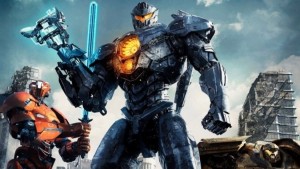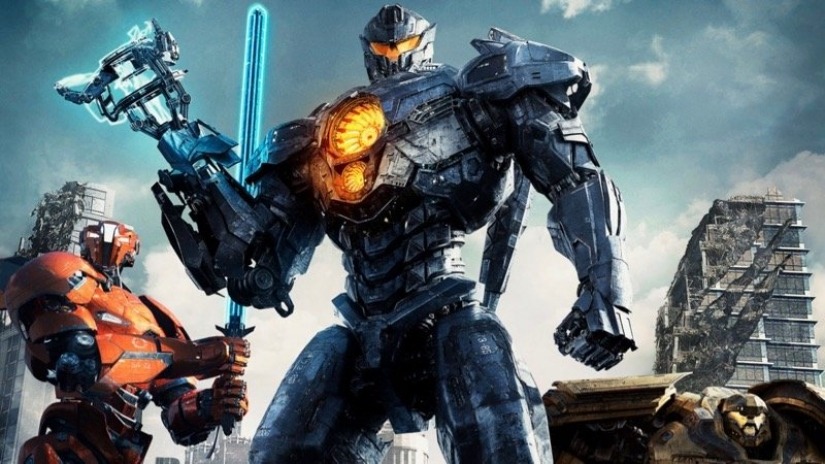Review: Pacific Rim Uprising (2018)

Director Stephen S. DeKnight (Daredevil, Buffy the Vampire Slayer, Spartacus, Angel) takes the reins from Guillermo Del Toro in this sequel to the 2013 cult hit monsters vs. robots film in a mostly successful attempt to flesh it out into a potential international franchise.
The first thing you have to keep in mind when watching Pacific Rim Uprising, directed by Stephen S. DeKnight for Thomas Tull’s Legedanry Pictures, is that this is not the film Guillermo Del Toro would have made were he to direct a sequel to his 2013 Pacific Rim. This film picks up a decade after the events of the original Pacific Rim; a world where Jaegers, the giant mechas that defeated the extra-dimensional monsters known as kaiju in the original, are now tightly regulated and private business enterprises work with the government and its Pan-Pacific Defence Corps for contracts to build and supply them. There’s a black market industry in salvaging armament and supplies from fallen jaegers and this is where we meet Jake Pentecost (Jon Boyega), the son of Pacific Rim’s fallen hero, Marshall Stacker Pentercost (Idris Elba). Jake lives his life on the edge of this black market and during a heist gone wrong, he meets Amara Namani (Cailee Spaeny), a young girl who has built a jaeger out of scrap materials, and the two are drafted into working with the PPDC after Jake calls in a marker from his adopted sister, Marshall Mako Mori (a criminally under-utilized Rinko Kikuchi). The PPDC is on the brink of a vote where its pilots might be decommissioned in favor of remote drone operated jaegers designed by Dr. Newt Geiszler (Charlie Day) and built by Shao Industries, a large military subcontracter operated by Liwen Shoa (Jing Tian from Kong: Skull Island). Mori is wary of these pilotless jaegers, as is Nate Lambert (Scott Eastwood), Jake’s former jaeger co-pilot and rival, with whom he is tasked to train a new generation of jeager pilots and operate Gipsy Avenger, a revitalized version of the Gipsy Danger jaeger from the 2013 film. After an unprovoked attack on the eve of the vote and its disastrous consequences. Nate and Jake must try to figure out if Shao Industries can be trusted, while prepping the newest generation of jaeger pilots against a new more dangerous threat.
Pacific Rim Uprising ia clearly designed from the outset to spin Del Toro’s one off tale about man vs monsters into a Fast and The Furious style franchise driven towards an international audience. There is a lot of emphasis placed on the multinational crew of young would-be jaeger pilots and their distinctive jaegers (whose designs vary from Mechwarrior inspired Bracer Phoenix to Gundam-lite Saber Athena). It doesn’t shy away from the consequences of giant robots battling (even if there is one death scene that I vehemently disagree with and feel is completely short sighted). The emphasis on the bond developing between the would-be jeager pilots through the film echoes the family dynamic from the Fast and the Furious films and clearly Legendary would love it if this film becomes the science fiction equivalent to that franchise. That’s not to say there aren’t solid performances amongst the film’s cast. Cailee Spaeny’s Amara is full of moxie and a throwback to the original film’s journey of making Mako Mori a hero. Amara is a cross between Firefly’s Kaylee and Megan Ward’s robo scrapper character from Robot Jox 2; her character has the best chance of connecting with fans of the original as does her handmade mini-jaeger Scrapper. Her relationship with Boyega’s Pentecost also mirrors the relationship between Charlie Hunnam’s Raleigh Bennett and Mako Mori in the first film, serving as good connective tissue. Some characters fare less well. Jing Tian’s character Shao seems to have her motivations driven moreso by plot convenience than solid characterization, but her character has a journey even if her arc is a bit murky. Eastwood’s Lambert serves as both a mentor and foil for Pentecost and this limits our ability to really latch onto him as a secondary foil, his closest equivalent is Rob Kazinsky’s Chuck Hansen in the first film, but he tends to fade into the background as his arc isnt full realized. Adria Arjona’s Jules is supposed to serve as the key to a love interest angle as we’re told Lambert and Pentecost are both interested in her; but that angle doesn’t really pay-off. The film’s jeager fight scenes are all set in bright daylight surrounded by glittering skyscrapers and this makes the proceedings seem a bit more cartoony in nature than those in Pacific Rim. In many ways, the shift away from fetishization of Japan in this film makes the film seem much more of a tokusatsu piece; it feels like an Asian Power Rangers big budget film, down to little easter eggs (a fight in Japan takes place by the famous Gundam statue in Odaiba). That feeling also permeates to the excitement and feel of the new generation of jeager pilots. Even if the film isn’t the caliber of Del Toro’s, its fun; its never a chore to sit through and there’s genuine eye candy in the movement and battles of giant mecha and monsters. This isn’t Del Toro’s Pacific Rim, but it doesn’t feel as soulless as the Paramount Transformers films; there’s some nuggets mined from the first film to set up this film’s big bad. Pacific Rim Uprising isn’t the sequel we would’ve gotten from Del Toro, but it takes the mythology in a new direction for someone else to have fun with and doesn’t overturn the sandbox too much.



